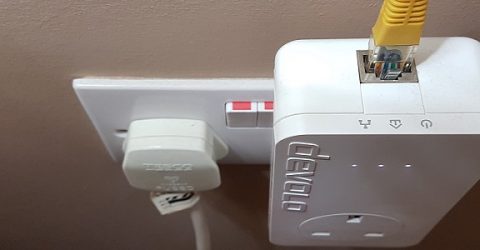How Powerline adaptors can transform your broadband

Although home broadband has transformed the way we work, socialise and relax, it’s not always as reliable as we’d like.
Broadband providers tend to supply cheap routers, whose modest internal aerials struggle to reach distant corners of our homes.
And while some companies now offer discounts if their WiFi doesn’t reach the attic and garden shed, a few pounds off your monthly bill is scant consolation.
Even then, you’ll need the latest hardware and a fairly expensive monthly contract to enjoy the prospect of dependable WiFi while sunbathing in the garden.
This is compounded by the inherent flakiness of WiFi, which operates across a very congested part of the radio frequency spectrum.
Everything from baby monitors to neighbouring broadband routers may cause interference, slowing data transmission or resulting in momentary drop-outs.
Fortunately, there is a solution for many larger devices – broadband over Powerline.
It’s easy to set up, completely portable, and far more stable than WiFi.
I’ve got the Power
We all know Ethernet cables represent the best way to connect devices to broadband.
These chunky cables transmit data far faster than WiFi, with minimal interference from other electrical hardware.
That’s why ISPs always ask you to connect a computer or other device to your router with an Ethernet cable, when you ring up to report a fault or outage.
A Powerline adaptor represents one way to do this, admittedly at a cost of £50 to £100.
It effectively links your broadband router to the electrical sockets around your home.
Most dwellings have one circuit extending round the house, linking every plug socket.
A Powerline adaptor enables data to flow along these highly efficient cables, turning sockets into extensions of the router itself.
In other words, you can ‘hardwire’ devices to the router, even if they’re in a different room or on a separate floor of the house.
Achieving broadband over Powerline involves plugging a proprietary adaptor into the wall socket beside your broadband hub or router, and connecting the two with an Ethernet cable.
You can then plug satellite adaptors (resembling outsized lamp timers) into other plug sockets around the house, connecting them to a device via another Ethernet cable.
Devices with Ethernet ports tend to include desktop and laptop computers, TVs and media centres, games consoles and smart home devices like Hive.
Instead of connecting through WiFi, devices should automatically default to the faster and more stable Ethernet connection.
This is an effective way of keeping important hardware like medical equipment connected all the time, without having to run Ethernet cables through the house or install phone sockets.
For activities like gaming and streaming, the difference in speeds can be dramatic. Plus, newly-connected hardware won’t use WiFi any longer, which benefits other wireless devices.
The latest Powerline adaptors achieve speeds of up to 1.3Gbps, which is faster than any current domestic internet connection – they certainly won’t slow down data transfers.
Security is also superior. Instead of using WiFi (which can be monitored or hacked), Powerline offers 128-bit encryption – and electrical signals can’t be intercepted by third parties.
Things to be aware of
First, you’ll need to check if your home has a single electrical circuit. Modern houses do, as will most flats and bungalows, but older houses may have a separate circuit on each floor.
Next, you’ll need to buy the same brand of Powerline adaptors. Several companies manufacture them – Devolo, Netgear, TP-Link – but their products are incompatible.
You’ll need a master adaptor to pump broadband signals into the electricity circuits, satellite units to extract it at plug sockets, and a handful of Ethernet cables.
These cables have varying connection speeds. Older Cat5 wires top out at 100Mbps, whereas the latest Cat7 cables will outperform even a 1Gbps internet connection.
It can take several minutes for one Powerline adaptor to detect another, often requiring you to press a button on the receiver to make it discoverable.
Adaptors tend to be bulky, and you won’t fit two side-by-side in a double wall socket. However, adaptors with twin outputs support two hardwired devices at once.
Broadband over Powerline can conflict with other mains-powered devices like tumble dryers and vacuum cleaners, so they’re not entirely immune to interference.
And while you can’t plug a Powerline adaptor into a surge-protected extension lead or socket bank, many adaptors have front-facing plug sockets capable of powering extension leads.






